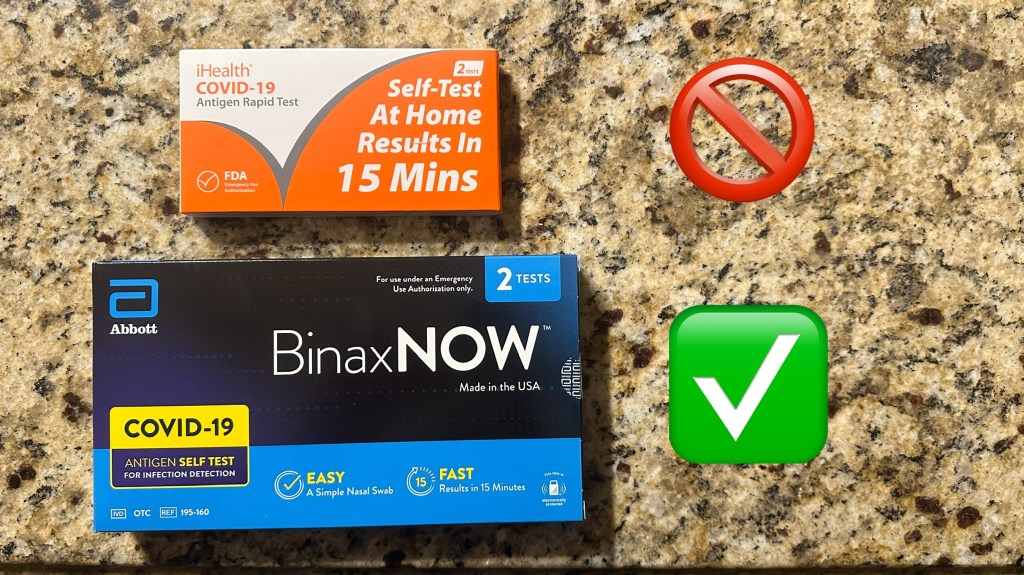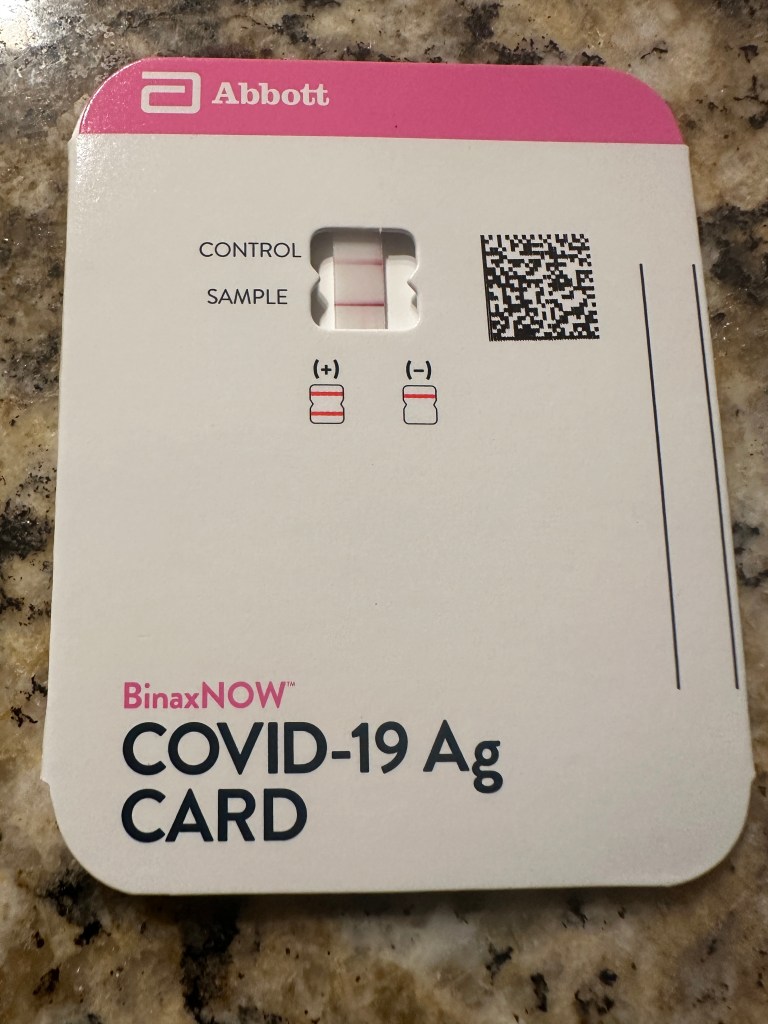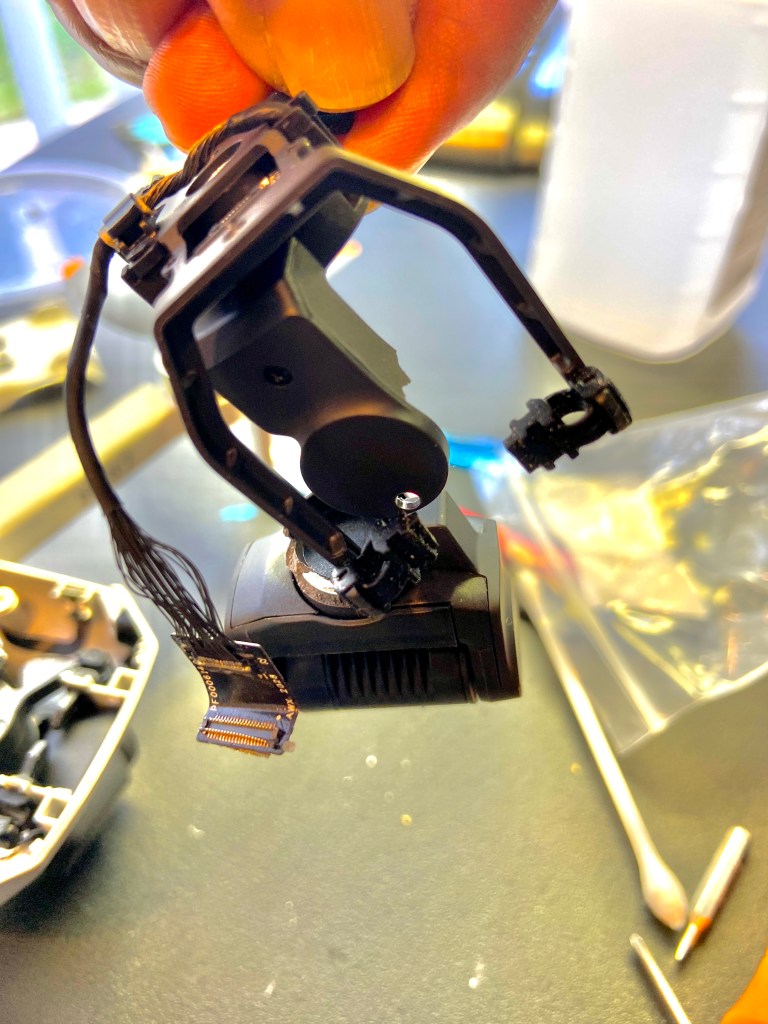I was never one for team sports. When I was a kid I was too short for basketball, too small for football, and baseballs seem to hit me more than I hit them. Oh, I tried, you’d have to give me an ‘A’ for effort, but my lack of speed, agility, and mass relegated me to always being the last one to get picked for teams, if I got picked at all. I didn’t mind so much. I tended to like one on one sports where one person matches his or her skills against those of another, like tennis, boxing or archery. Unfortunately those types of sports were hard to get into in my west Baltimore neighborhood in the late 1950s.
I suppose that, since I was rejected by team sports, I rejected them. I never watched them on TV or followed team statistics. I couldn’t care less what team got into whatever playoffs or what player got traded to which team. I paid enough attention to sports to appreciated the skills involved, so if I happen to be sitting in a bar and football highlights are showing, I’ll watch, not caring what team is playing or the eventual score, but to see the actual plays being skillfully executed by professionals. I appreciate what it takes to get to that level of skill.
So, no team sports for me. That is, until I got to be much older. I now play on a dart team and the team is in a local league. How I wound up on this team is a story in itself.
Back when I was still married I was looking for something that my then wife and I could play together and not wind up killing each other. One Christmas I decided to buy an electronic dartboard. It wasn’t the cheapest board around, but it wasn’t the best either. It was functional enough that it captured our interest on evenings when there wan’t much else to do. It also fit right into my ‘one-on-one’ sports mentality.
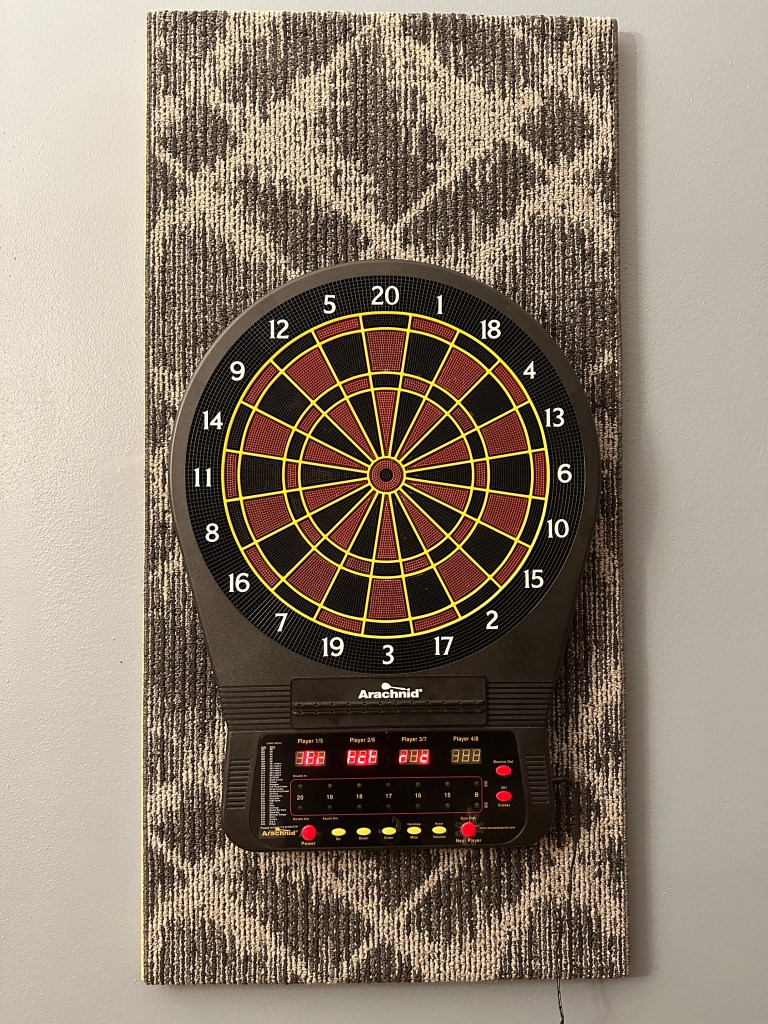
My ex and I played often and, while I was decent, my ex got to be really good. She had a very strange throw where she would swing her arms like a baseball pitcher winding up to sling a fast ball. She’d then would hurl the dart and, more often than not, she’d hit her target. It became a point of frustration for me with her winning so much, especially since I had practiced using tips I had picked up on YouTube. Seemed no matter how I tried, the woman would beat me time and again.
Did I mention how frustrating that was?
Yeah.
Anyway, after my divorce I decided that I wanted to increase my skills. I bought a real bristle board and metal tipped darts and hung the board in the garage of my new house. I envisioned having neighbors over to throw on warm summer evenings while chit-chatting and downing a cooler full of beer.
The neighbor thing never happened, however. I joined the Peace Corps and rented out my house. But darts wasn’t done with me. There was another Peace Corps volunteer in Arandis, the town I wound up serving in, and he was a darts player and taught some of the locals how to play. He even convinced one of the bar owners to set up a dartboard in an unused room.
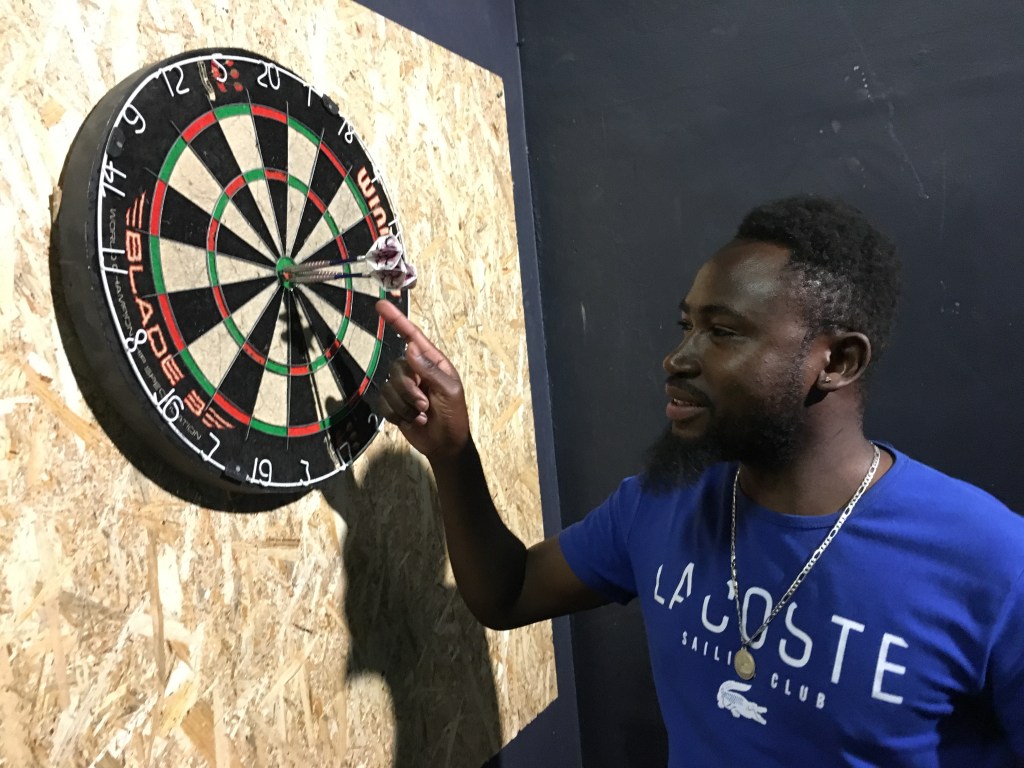
So, after work, I would head to that bar, order a bottle to Windhoek Lager, the official beer of Namibia, and set about playing against the locals. Once again, I ran into frustration because the local dart players were good, often better than me. Still, it was fun and I got to hone my dart throwing skills a bit.
I actually got fairly decent, good enough to win a trophy and N$200 (about US$10). Not long after that, Covid hit and all Peace Corps volunteers were sent home. When I finally moved back into my house in 2022 I decided to get another electronic dart board. This one is pretty decent with lots of different games and I can play against the builtin computer. It’s been fun to mess around with it, but I found that I really missed throwing metal tipped darts

There’s a difference between soft tip darts used with electronic boards and metal tipped darts used on bristle boards. Soft tip darts tend to be lighter and can bounce off the board if you arch your throws. A good metal tipped dart on a good bristle board is far more forgiving, but the target areas are a bit smaller. Also, throwing a well made metal tipped dart onto a well made bristle dart board gives a satisfying, “thunk!” when dart meets board.
Anyway, back to how I joined a dart team. I was at an Irish pub in Winter Park, Florida called Fiddler’s Green and, lo and behold, they have three bristle dart boards! Many bars and pubs in and around Orlando, if they have dart boards at all, opt for the electronic boards where you have to pay to play. Fiddler’s Green didn’t go that route and their dart boards are often occupied by local kids from Rollins College. The pub even hosts ‘Open Darts’ on Tuesdays where anyone can play and possibly win up to $25 in Fiddler’s Green gift cards.
After seeing those boards I decided to buy a good set of metal tipped darts and started showing up on Tuesdays to try my hand at winning a gift card or two. As it happened, one Tuesday night the captain of Fiddler’s Green’s league team was playing and I guess I made an impression on him, because he asked me to join the team. At that point I was just a so-so player, hardly consistent in my scoring, and I barely understood the rules of the games the league plays. Still, I decided to give it a go.
As far as I can tell, there are two dart leagues in the Orlando area; one for soft tipped darts played on electronic boards, one for metal tipped darts. I don’t know much about the soft tipped dart league, but I do know they appear to be pretty active.

We have 17 teams in the metal tipped dart league, which is divided into 4 tiers. During the season the scores a team achieves by winning matches determines the team’s position in the league standings and what tier that team is in at the end of the season. The playoffs are between the teams in each tier. My team won 1st place in tier 2 both seasons of 2022 and have trophies to show for it. We made it into tier 1 last season, but didn’t do well enough to win a trophy.
The first season I played I won as many as I lost, but I found that I enjoyed hanging out with and cheering on my teammates. This is my third season with the team and it’s been a lot of fun. We’ve just finished the second 2023 season and, once again, we’re in tier two. We are third place in the tier going into the playoffs. I don’t think we’ll win a trophy this season either, but I’m gonna give it my best shot, or throw, which seems more appropriate.
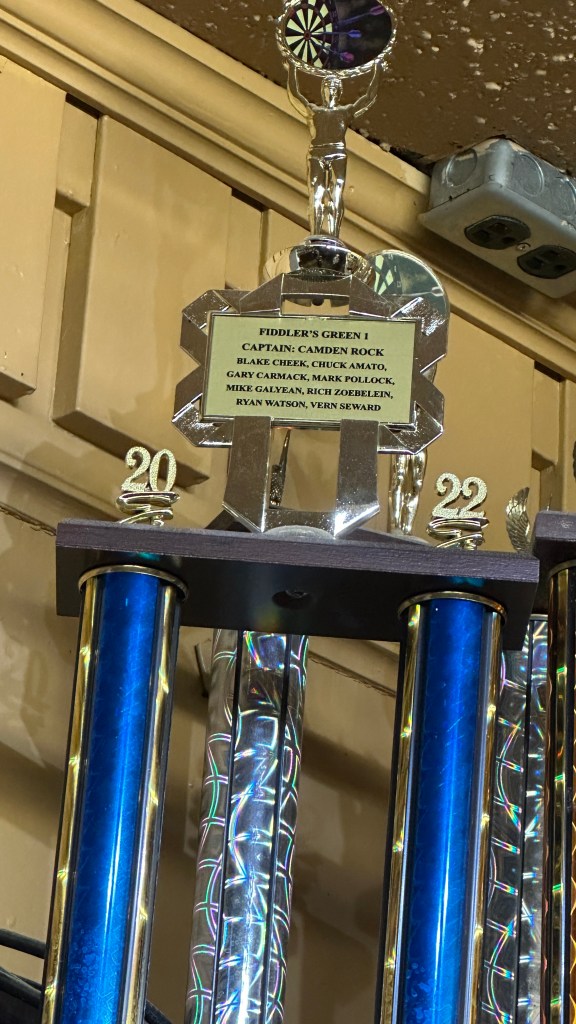
Like any sports, darts requires skills which are only gained through practice, but you don’t have to be a sharp shooter to have a blast. Almost anyone can play. If you can throw a dart and hit the board, game on!
If you’re new to darts and would like to see how well you might like it, I suggest you start off with soft tipped darts and an electronic board. The board will offer lots of different games with plenty of options. I would avoid the very cheap boards, they are far more trouble than they are worth. Expect to pay between US$50 to US$100 for a decent electronic board. I recommend the Arachnid Cricket Pro 450. It has everything you need to get started playing.
If you’d like more info about metal tipped darts, leave a comment and I’ll get back to you.
I’ll also update this to let you know how my team does in the playoffs, which starts tonight (Jan. 29, 2024). Wish us luck.
Stay tuned.
Update: Last night’s match was fun, but my team didn’t do as well as we’d like. That match was against the top team in our tier. The final score was 3:7.
Several very close games where it could have gone our way, but it was not to be.
I lost my singles cricket match. I just couldn’t get my act together. My doubles cricket match was better. We won that one.
Hopefully we’ll do better next week.
Last Update: We came in third in our tier. Not as good as last season, but better than I had expected. There will be some turnover on the team as well, people leaving to pursue other interests, people joining. In all it was a fun season.
As I said, stay tuned.

